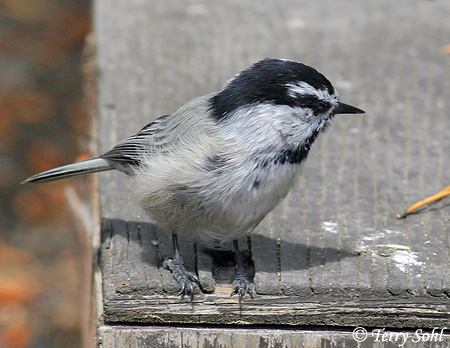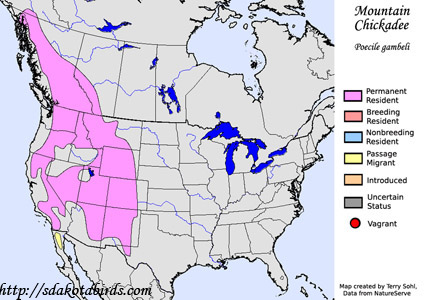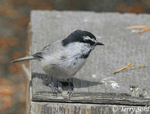Mountain Chickadee
Poecile gambeli
| Length: 5.5 inches | Wingspan: 7.5 inches | Seasonality: Casual Visitor |
| ID Keys: Black cap with white eyebrow, black bib | ||
 Mountain
Chickadees generally replace other
chickadees in the higher elevation conifer forests of the western United
States. Like the Black-Capped
Chickadee, the Mountain Chickadee can often be found in mixed flocks of
small birds. In some parts of North America, several of the different
Chickadee species can be found in one location, such as Mountain Chickadees,
Black-capped Chickadees,
Boreal Chickadees, and
Chestnut-backed
Chickadees all possible to be found in Glacier National Park in Montana.
Mountain Chickadees will often attempt to frighten potential predators away from
nest locations by issuing a hiss sounding similar to a snake's.
Mountain
Chickadees generally replace other
chickadees in the higher elevation conifer forests of the western United
States. Like the Black-Capped
Chickadee, the Mountain Chickadee can often be found in mixed flocks of
small birds. In some parts of North America, several of the different
Chickadee species can be found in one location, such as Mountain Chickadees,
Black-capped Chickadees,
Boreal Chickadees, and
Chestnut-backed
Chickadees all possible to be found in Glacier National Park in Montana.
Mountain Chickadees will often attempt to frighten potential predators away from
nest locations by issuing a hiss sounding similar to a snake's.
Habitat:
Prefers coniferous forest for breeding, but can also occasionally be found in lower-elevation mixed or deciduous woodlands.
Diet:
Insects, spiders, seeds, and berries.
Behavior:
Very active forager, moving quickly through the forest canopy in search of food. Will usually move through leaves and foliage and glean food items, but may also occasionally hover while foraging. Usually feeds fairly high in the forest canopy, making it difficult to spot.
Breeding:
Non-breeder in South Dakota
Song:
Migration:
Generally non-migratory, although some higher elevation birds may move to lower elevations for the winter.
Interactive eBird Map:
Click here to access an interactive eBird map of Mountain Chickadee sightings
Similar Species:
Black-Capped Chickadee, Boreal Chickadee, Chestnut-backed Chickadee
Conservation Status:
Generally stable throughout its range.
Bird Feeders:
Nuts, sunflower seeds, baby chick scratch, suet.
Birdhouses:
Will nest in birdhouses designed for Chickadees.
Further Information:
1) USGS Patuxent Bird Identification InfoCenter, Mountain Chickadee
2) BirdWeb - Mountain Chickadee
3) Audubon Guide - Mountain Chickadee
Photo Information:
July 2004 - Yellowstone National Park, Wyoming - Terry Sohl
| Click on the map below for a higher-resolution view |
 |
| South Dakota Status: Casual visitor to the Black Hills of South Dakota. Common in nearby mountains of Wyoming. |
Additional Mountain Chickadee Photos

